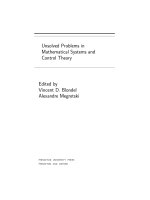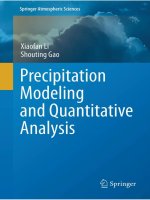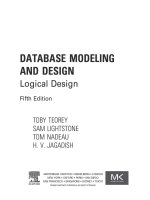understanding search engines mathematical modeling and text retrieval
Bạn đang xem bản rút gọn của tài liệu. Xem và tải ngay bản đầy đủ của tài liệu tại đây (6.01 MB, 136 trang )
Understanding
Search
Engines
SOFTWARE
•
ENVIRONMENTS
•
TOOLS
The
series
includes
handbooks
and
software guides
as
well
as
monographs
on
practical
implementation
of
computational
methods,
environments,
and
tools.
The
focus
is on
making
recent
developments
available
in a
practical
format
to
researchers
and
other
users
of
these
methods
and
tools.
Editor-in-Chief
Jack
J.
Dongarra
University
of
Tennessee
and Oak
Ridge
National
Laboratory
Editorial Board
James
W.
Demmel,
University
of
California,
Berkeley
Dennis
Gannon,
Indiana
University
Eric
Grosse,
AT&T
Bell
Laboratories
Ken
Kennedy,
Rice
University
Jorge
J.
More,
Argonne
National
Laboratory
Software, Environments,
and
Tools
Michael
W.
Berry
and
Murray
Browne,
Understanding
Search
Engines:
Mathematical Modeling
and
Text
Retrieval,
Second Edition
Craig
C.
Douglas,
Gundolf
Haase,
and
Ulrich Langer,
A
Tutorial
on
Elliptic
PDE
Solvers
and
Their
Parallelization
Louis
Komzsik,
The
Lanczos
Method: Evolution
and
Application
Bard Ermentrout, Simulating, Analyzing,
and
Animating Dynamical
Systems:
A
Guide
to
XPPAUT
for
Researchers
and
Students
V.
A.
Barker,
L. 5.
Blackford,
J.
Dongarra,).
Du
Croz,
S.
Hammarling,
M.
Marinova,
J.
Wasniewski,
and P.
Yalamov,
LAPACK95
Users' Guide
Stefan
Goedecker
and
Adolfy Hoisie, Performance Optimization
of
Numerically Intensive
Codes
Zhaojun Bai,
James
Demmel,
Jack
Dongarra, Axel Ruhe,
and
Henk
van der
Vorst,
Templates
for the
Solution
of
Algebraic
Eigenvalue
Problems:
A
Practical Guide
Lloyd
N.
Trefethen, Spectral Methods
in
MATLAB
E.
Anderson,
Z.
Bai,
C.
Bischof,
S.
Blackford,
J.
Demmel,
J.
Dongarra,
J. Du
Croz,
A.
Greenbaum,
S.
Hammarling,
A.
McKenney,
and D.
Sorensen,
LAPACK
Users'
Guide,
Third
Edition
Michael
W.
Berry
and
Murray Browne, Understanding
Search
Engines:
Mathematical Modeling
and
Text
Retrieval
Jack
J.
Dongarra, lain
S.
Duff,
Danny
C.
Sorensen,
and
Henk
A. van der
Vorst, Numerical
Linear
Algebra
for
High-Performance
Computers
R.
B.
Lehoucq,
D. C.
Sorensen,
and C.
Yang,
ARPACK
Users'
Guide: Solution
of
Large-Scale
Eigenvalue
Problems
with Implicitly
Restarted
Arnoldi Methods
Randolph
E.
Bank,
PLTMG:
A
Software
Package
for
Solving
Elliptic
Partial
Differential
Equations,
Users'
Guide
8.0
L.
S.
Blackford,
J,
Choi,
A.
Cleary,
E.
D'Azevedo,
J.
Demmel,
I.
Dhillon,
J.
Dongarra,
S.
Hammarling,
G.
Henry,
A.
Petitet,
K.
Stanley,
D.
Walker,
and R, C,
Whaley,
ScaLAPACK
Users' Guide
Greg
Astfalk,
editor,
Applications
on
Advanced Architecture
Computers
Francoise
Chaitm-Chatelin
and
Valerie
Fraysse,
Lectures
on
Finite
Precision
Computations
Roger
W.
Hockney,
The
Science
of
Computer Benchmarking
Richard
Barrett,
Michael
Berry, Tony
F.
Chan,
James
Demmel,
June
Donato,
Jack
Dongarra, Victor Eijkhout,
Roldan
Pozo, Charles Romine,
and
Henk
van der
Vorst,
Templates
for the
Solution
of
Linear
Systems:
Building Blocks
for
Iterative Methods
E.
Anderson,
Z.
Bai,
C.
Bischof,
J.
Demmel,
J.
Dongarra,
J. Du
Croz,
A.
Greenbaum,
S.
Hammarling,
A.
McKenney,
S.
Ostrouchov,
and D.
Sorensen,
LAPACK
Users'
Guide, Second Edition
Jack
J.
Dongarra, lain
S.
Duff,
Danny
C.
Sorensen,
and
Henk
van der
Vorst, Solving
Linear
Systems
on
Vector
and
Shared
Memory Computers
J.
J.
Dongarra,
J. R.
Bunch,
C. B.
Moler,
and C, W,
Stewart,
linpack
Users'
Guide
Understanding
Search Engines
Mathematical
Modeling
and
Text
Retrieval
Second Edition
Michael
W.
Berry
University
of
Tennessee
Knoxville, Tennessee
Murray
Browne
University
of
Tennessee
Knoxville, Tennessee
Society
for
Industrial
and
Applied Mathematics
Philadelphia
Copyright
©
2005
by the
Society
for
Industrial
and
Applied
Mathematics.
10987654321
All
rights reserved. Printed
in the
United
States
of
America.
No
part
of
this
book
may be
reproduced,
stored,
or
transmitted
in any
manner
without
the
written permission
of the
publisher.
For
information, write
to the
Society
for
Industrial
and
Applied
Mathematics,
3600
University
City
Science
Center, Philadelphia,
PA
19104-2688.
Trademarked names
may be
used
in
this book
without
the
inclusion
of a
trademark
symbol.
These names
are
used
in an
editorial
context
only;
no
infringement
is
intended.
The
illustration
on the
front cover
was
originally sketched
by
Katie Terpstra
and
later redesigned
on a
color
workstation
by
Eric
Clarkson
and
David
Rogers.
The
concept
for the
design came from
an
afternoon
in
which
the
co-authors
deliberated
on the
meaning
of
"search."
Library
of
Congress Cataloging-in-Publication
Data
Berry,
Michael
W.
Understanding search engines
:
mathematical
modeling
and
text
retrieval
/
Michael
W.
Berry, Murray Browne.—2nd
ed.
p. cm.
Includes
bibliographical
references
and
index.
ISBN
0-89871-581-4 (pbk.)
1.
Web
search engines.
2.
Vector
spaces.
3.
Text processing
(Computer science)
I,
BrovYne,
Murray.
II.
Title.
TK5105.884.B47
2005
025.04-dc22
2005042539
is
a
registered trademark.
To
our
families
(Teresa,
Amanda,
Rebecca,
Cynthia,
and
Bonnie)
This page intentionally left blank
Contents
Preface
to the
Second Edition
xi
Preface
to the
First Edition
xv
1
Introduction
1
1.1
Document File Preparation
2
1.1.1 Manual Indexing
2
1.1.2 File Cleanup
3
1.2
Information Extraction
4
1.3
Vector Space Modeling
4
1.4
Matrix Decompositions
6
1.5
Query Representations
7
1.6
Ranking
and
Relevance Feedback
8
1.7
Searching
by
Link Structure
9
1.8
User Interface
9
1.9
Book
Format
10
2
Document
File
Preparation
11
2.1
Document Purification
and
Analysis
12
2.1.1 Text Formatting
13
2.1.2
Validation
14
2.2
Manual Indexing
14
2.3
Automatic Indexing
16
2.4
Item Normalization
19
2.5
Inverted File Structures
21
2.5.1
Document File
22
2.5.2
Dictionary List
23
2.5.3
Inversion List
24
VII
viii
Contents
2.5.4
Other File Structures
26
3
Vector Space Models
29
3.1
Construction
29
3.1.1
Term-by-Document Matrices
30
3.1.2 Simple Query Matching
32
3.2
Design Issues
34
3.2.1 Term Weighting
34
3.2.2
Sparse Matrix Storage
38
3.2.3 Low-Rank Approximations
40
4
Matrix Decompositions
45
4.1 QR
Factorization
45
4.2
Singular Value Decomposition
51
4.2.1 Low-Rank Approximations
55
4.2.2
Query Matching
55
4.2.3
Software
57
4.3
Semidiscrete Decomposition
58
4.4
Updating Techniques
59
5
Query Management
63
5.1
Query Binding
63
5.2
Types
of
Queries
65
5.2.1 Boolean Queries
65
5.2.2
Natural Language Queries
66
5.2.3
Thesaurus
Queries
66
5.2.4 Fuzzy Queries
67
5.2.5
Term Searches
67
5.2.6
Probabilistic Queries
68
6
Ranking
and
Relevance Feedback
71
6.1
Performance
Evaluation
72
6.1.1 Precision
73
6.1.2
Recall
73
6.1.3 Average Precision
74
6.1.4 Genetic Algorithms
75
6.2
Relevance Feedback
75
Contents
ix
7
Searching
by
Link
Structure
77
7.1
HITS Method
79
7.1.1 HITS Implementation
81
7.1.2
HITS Summary
82
7.2
PageRank Method
84
7.2.1
PageRank Adjustments
85
7.2.2
PageRank Implementation
87
7.2.3
PageRank Summary
88
8
User
Interface
Considerations
89
8.1
General Guidelines
89
8.2
Search Engine Interfaces
90
8.2.1 Form Fill-in
91
8.2.2
Display Considerations
92
8.2.3 Progress Indication
92
8.2.4
No
Penalties
for
Error
93
8.2.5
Results
93
8.2.6
Test
and
Retest
94
8.2.7
Final Considerations
95
9
Further
Reading
97
9.1
General Textbooks
on IR 97
9.2
Computational Methods
and
Software
98
9.3
Search Engines
100
9.4
User Interfaces
100
Bibliography
103
Index
113
This page intentionally left blank
Preface
to the
Second
Edition
Anyone
who has
used
a web
search engine with
any
regularity knows
that
there
is an
element
of the
unknown with every query. Sometimes
the
user
will
type
in a
stream-of-consciousness query,
and the
documents retrieved
are a
perfect match, while
the
next query
can be
seemingly succinct
and
focused,
only
to
earn
the
bane
of all
search
results
— the no
documents
found
response. Oftentimes
the
same queries
can be
submitted
on
different
databases
with
just
the
opposite results.
It is an
experience aggravating
enough
to
swear
off
doing
web
searches
as
well
as
swear
at the
developers
of
such
systems.
However,
because
of the
transparent nature
of
computer software design,
there
is a
tendency
to
forget
the
decisions
and
trade-offs
that
are
constantly
made throughout
the
design process
affecting
the
performance
of the
system.
One
of the
main objectives
of
this
book
is to
identify
to the
novice search
engine
builder, such
as the
senior level computer science
or
applied mathe-
matics student
or the
information sciences graduate student specializing
in
retrieval systems,
the
impact
of
certain decisions
that
are
made
at
various
junctures
of
this
development.
One of the
major decisions
in
developing
in-
formation retrieval systems
is
selecting
and
implementing
the
computational
approaches within
an
integrated software environment. Applied mathemat-
ics
plays
a
major role
in
search engine performance,
and
Understanding
Search
Engines
(or
USE)
focuses
on
this area, bridging
the gap
between
the
fields
of
applied
mathematics
and
information management, disciplines
which previously have
operated
largely
in
independent domains.
But USE
does
not
only
fill the gap
between applied mathematics
and
information
management,
it
also
fills a
niche
in the
information retrieval
literature.
The
work
of
William Frakes
and
Ricardo Baeza-Yates (eds.),
Information
Retrieval Data Structures
and
Algorithms,
a
1992 collection
of
journal
articles
on
various
related
topics, Gerald Kowalski's (1997)
Infor-
mation Retrieval Systems:
Theory
and
Implementation,
a
broad
overview
XI
xii
Preface
to the
Second Edition
of
information retrieval systems,
and
Ricardo Baeza-Yates
and
Berthier
Ribeiro-Neto's (1999) Modern Information Retrieval,
a
computer-science
perspective
of
information retrieval,
are all fine
textbooks
on the
topic,
but
understandably they lack
the
gritty details
of the
mathematical computa-
tions needed
to
build more
successful
search engines.
With this
in
mind,
USE
does
not
provide
an
overview
of
information
retrieval
systems
but
prefers
to
assume
the
supplementary role
to the
above-
mentioned books. Many
of the
ideas
for USE
were
first
presented
and
devel-
oped
as
part
of a
Data
and
Information Management course
at the
University
of
Tennessee's Computer Science Department,
a
course which
won the
1997
Undergraduate Computational Engineering
and
Science Award sponsored
by
the
United
States
Department
of
Energy
and the
Krell Institute.
The
course, which required
student
teams
to
build their
own
search engines,
has
provided invaluable background material
in the
development
of
USE.
As
mentioned earlier,
USE
concentrates
on the
applied mathematics por-
tion
of
search engines. Although
not
transparent
to the
pedestrian search
engine
user, mathematics plays
an
integral part
in
information retrieval sys-
tems
by
computing
the
emphasis
the
query terms have
in
their relationship
to the
database. This
is
especially true
in
vector space modeling,
which
is one
of
the
predominant techniques used
in
search engine design. With vector
space modeling, traditional orthogonal matrix decompositions
from
linear
algebra
can be
used
to
encode both terms
and
documents
in
K-dimensional
space.
There
are
other computational methods
that
are
equally
useful
or
valid.
In
fact,
in
this
edition
we
have included
a
chapter
on
link-structure algo-
rithms
(an
approach used
by the
Google search engine) which arise
from
both graph theory
and
linear algebra. However,
in
order
to
teach
future
developers
the
intricate details
of a
system,
a
single approach
had to be
selected.
Therefore
the
reader
can
expect
a
fair
amount
of
math, including
explanations
of
algorithms
and
data
structures
and how
they operate
in in-
formation
retrieval systems. This book
will
not
hide
the
math (concentrated
in
Chapters
3, 4, and 7), nor
will
it
allow itself
to get
bogged down
in it ei-
ther.
A
person with
a
nonmathematical background (such
as an
information
scientist)
can
still
appreciate
some
of the
mathematical intricacies involved
with building search engines without reading
the
more technical Chapters
3,
4,
and 7.
To
maintain
its
focus
on the
mathematical approach,
USE
has
purposely
avoided
digressions into
Java
programming, HTML programming,
and how
Preface
to the
Second Edition xiii
to
create
a web
interface.
An
informal conversational approach
has
been
adopted
to
give
the
book
a
less intimidating tone, which
is
especially
im-
portant considering
the
possible multidisciplinary backgrounds
of its
poten-
tial
readers; however,
standard
math
notation
will
be
used. Boxed items
throughout
the
book contain ancillary information, such
as
mathematical
examples,
anecdotes,
and
current practices,
to
help guide
the
discussion.
Websites providing
software
(e.g.,
CGI
scripts, text parsers, numerical
soft-
ware)
and
text
corpora
are
provided
in
Chapter
9.
Acknowledgments
In
addition
to
those
who
assisted with
the first
edition,
the
authors would
like
to
gratefully
acknowledge
the
support
and
encouragement
of
SIAM,
who
along with
our
readers encouraged
us to
update
the
original book.
We
appreciate
the
helpful
comments
and
suggestions
from
Alan Wallace
and
Gayle Baker
at
Hodges Library, University
of
Tennessee, Scott Wells
from
the
Department
of
Computer Science
at the
University
of
Tennessee,
Mark
Gauthier
at
H.W. Wilson Company, June Levy
at
Cinhahl Information
Systems,
and
James
Marcetich
at the
National Library
of
Medicine. Special
thanks
go to Amy
Langville
of the
Department
of
Mathematics
at
North
Carolina
State University,
who
reviewed
our new
chapter
on
link structure-
based algorithms.
The
authors would also like
to
thank graphic designer
David
Rogers,
who
updated
the fine
artwork
of
Katie Terpstra,
who
drew
the
original
art.
Hopefully,
USE
will
help
future
developers, whether they
be
students
or
software
engineers,
to
lessen
the
aggravation encountered with
the
current
state
of
search engines.
It
continues
to be a
dynamic time
for
search engines
and the
future
of the Web
itself,
as
both ultimately depend
on how
easily
users
can find the
information they
are
looking for.
MICHAEL
W.
BERRY
MURRAY
BROWNE
This page intentionally left blank
Preface
to the
First
Edition
Anyone
who has
used
a web
search engine with
any
regularity knows
that
there
is an
element
of the
unknown with every query. Sometimes
the
user
will
type
in a
stream-of-consciousness query,
and the
documents retrieved
are a
perfect match, while
the
next query
can be
seemingly succinct
and
focused,
only
to
earn
the
bane
of all
search results
— the no
documents
found
response. Oftentimes
the
same queries
can be
submitted
on
different
databases
with just
the
opposite results.
It is an
experience aggravating
enough
to
make
one
swear
off
doing
web
searches
as
well
as
swear
at the
developers
of
such systems.
However,
because
of the
transparent nature
of
computer
software
design,
there
is a
tendency
to
forget
the
decisions
and
trade-offs
that
are
constantly
made throughout
the
design process
affecting
the
performance
of the
system.
One
of the
main objectives
of
this book
is to
identify
to the
novice search
engine
builder, such
as the
senior level computer science
or
applied mathe-
matics student
or the
information sciences graduate student specializing
in
retrieval systems,
the
impact
of
certain decisions
that
are
made
at
various
junctures
of
this
development.
One of the
major decisions
in
developing
in-
formation
retrieval systems
is
selecting
and
implementing
the
computational
approaches within
an
integrated software environment. Applied mathemat-
ics
plays
a
major role
in
search engine performance,
and
Understanding
Search
Engines
(or
USE]
focuses
on
this
area, bridging
the gap
between
the
fields
of
applied mathematics
and
information management, disciplines
that
previously have
operated
largely
in
independent domains.
But USE
does
not
only
fill the gap
between applied
mathematics
and
information
management,
it
also
fills a
niche
in the
information retrieval
literature.
The
work
of
William Frakes
and
Ricardo Baeza-Yates (eds.),
Information
Retrieval: Data Structures
&
Algorithms,
a
1992 collection
of
journal articles
on
various related topics,
and
Gerald Kowalski's (1997)
In-
formation Retrieval Systems:
Theory
and
Implementation,
a
broad overview
xv
xvi
Preface
to the
First Edition
of
information retrieval systems,
are fine
textbooks
on the
topic,
but
both
understandably lack
the
gritty details
of the
mathematical computations
needed
to
build more
successful
search engines.
With
this
in
mind,
USE
does
not
provide
an
overview
of
information
re-
trieval systems
but
prefers
to
assume
a
supplementary role
to the
aforemen-
tioned books. Many
of the
ideas
for USE
were
first
presented
and
developed
as
part
of a
Data
and
Information Management course
at the
University
of
Tennessee's Computer Science Department,
a
course which
won the
1997
Undergraduate Computational Engineering
and
Science Award sponsored
by
the
United
States
Department
of
Energy
and the
Krell
Institute.
The
course,
which required student teams
to
build their
own
search engines,
has
provided
invaluable background material
in the
development
of
USE.
As
mentioned earlier,
USE
concentrates
on the
applied mathematics por-
tion
of
search engines. Although
not
transparent
to the
pedestrian search
engine user, mathematics plays
an
integral
part
in
information retrieval sys-
tems
by
computing
the
emphasis
the
query terms have
in
their relationship
to the
database. This
is
especially true
in
vector space modeling,
which
is one
of
the
predominant techniques used
in
search engine design. With vector
space modeling,
traditional
orthogonal matrix decompositions
from
linear
algebra
can be
used
to
encode both terms
and
documents
in
K-dimensional
space.
However,
that
is not to say
that
other computational methods
are not
useful
or
valid,
but in
order
to
teach
future
developers
the
intricate details
of
a
system,
a
single approach
had to be
selected. Therefore,
the
reader
can
expect
a
fair
amount
of
math, including explanations
of
algorithms
and
data
structures
and how
they operate
in
information retrieval systems. This book
will
not
hide
the
math (concentrated
in
Chapters
3 and 4), nor
will
it
allow
itself
to get
bogged down
in it
either.
A
person with
a
nonmathematical
background (such
as an
information scientist)
can
still
appreciate
some
of
the
mathematical intricacies involved with building search engines without
reading
the
more technical Chapters
3 and 4.
To
maintain
its
focus
on the
mathematical approach,
USE
has
purposely
avoided digressions into
Java
programming, HTML programming,
and how
to
create
a web
interface.
An
informal conversational approach
has
been
adopted
to
give
the
book
a
less intimidating tone, which
is
especially
im-
portant considering
the
possible multidisciplinary backgrounds
of its
poten-
tial
readers; however, standard math notation
will
be
used. Boxed items
throughout
the
book contain ancillary information, such
as
mathematical
Preface
to the
First Edition xvii
examples, anecdotes,
and
current practices,
to
help guide
the
discussion.
Websites providing
software
(e.g.,
CGI
scripts,
text
parsers, numerical
soft-
ware)
and
text
corpora
are
provided
in
Chapter
9.
Acknowledgments
The
authors would
like
to
gratefully
acknowledge
the
support
and
encourage-
ment
of
SIAM,
the
United
States
Department
of
Energy,
the
Krell
Institute,
the
National Science Foundation
for
supporting related research,
the
Uni-
versity
of
Tennessee,
the
students
of
CS460/594
(fall
semester 1997),
and
graduate assistant Luojian Chen. Special thanks
go to
Alan Wallace
and
David Penniman
from
the
School
of
Information Sciences
at the
University
of
Tennessee, Padma Raghavan
and
Ethel Wittenberg
in the
Department
of
Computer Science
at the
University
of
Tennessee,
Barbara
Chen
at
H.W.
Wilson
Company,
and
Martha Ferrer
at
Elsevier Science
SPD for
their help-
ful
proofreading, comments,
and/or
suggestions.
The
authors would also
like
to
thank Katie Terpstra
and
Eric Clarkson
for
their
work
with
the
book
cover
artwork
and
design, respectively.
Hopefully,
this book
will
help
future
developers, whether they
be
stu-
dents
or
software
engineers,
to
lessen
the
aggravation encountered with
the
current
state
of
search engines.
It is a
critical time
for
search engines
and
the
future
of the Web
itself,
as
both ultimately depend
on how
easily users
can find the
information they
are
looking for.
MICHAEL
W.
BERRY
MURRAY BROWNE
This page intentionally left blank
DOONESBURY
©G.B. Trudeau. Reprinted with permission
of
UNIVERSAL PRESS
SYNDICATE.
All
rights reserved.
Chapter
1
Introduction
We
expect
a lot
from
our
search engines.
We ask
them vague questions
about topics
that
we are
unfamiliar about ourselves
and in
turn anticipate
a
concise,
organized response.
We
type
in
principal when
we
meant principle.
We
incorrectly type
the
name Lanzcos
and
fully
expect
the
search engine
to
know
that
we
really meant Lanczos. Basically
we are
asking
the
computer
to
supply
the
information
we
want, instead
of the
information
we
asked for.
In
short, users
are
asking
the
computer
to
reason
intuitively.
It is a
tall
order,
and in
some search systems
you
would probably have better success
if
you
laid your head
on the
keyboard
and
coaxed
the
computer
to try to
read your mind.
Of
course these problems
are
nothing
new to the
reference
librarian
who
works
the
desk
at a
college
or
public library.
An
experienced
reference
li-
brarian knows
that
a few
moments spent with
the
patron, listening, asking
questions,
and
listening some more,
can go a
long
way in
efficiently
direct-
ing
the
user
to the
source
that
will
fulfill
the
user's information needs.
In
the
computerized world
of
searchable
databases
this
same strategy
is
being
developed,
but it has a
long
way to go
before
being perfected.
There
is
another
problem with locating
the
relevant documents
for a re-
spective query,
and
that
is the
increasing size
of
collections.
Heretofore,
the
focus
of new
technology
has
been more
on
processing
and
digitizing
infor-
mation, whether
it be
text, images, video,
or
audio, than
on
organizing
it.
1
2
Chapter
1.
Introduction
It has
created
a
situation information designer Richard Saul Wurman [87]
refers
to as a
tsunami
of
data:
"This
is a
tidal wave
of
unrelated, growing
data
formed
in
bits
and
bytes, coming
in an
unorganized, uncontrolled, incoherent
cacophony
of
foam.
It's
filled
with
flotsam and
jetsam.
It's
filled
with
the
sticks
and
bones
and
shells
of
inanimate
and
animate
life.
None
of it is
easily related, none
of it
comes with
any
orga-
nizational methodology."
To
combat
this
tsunami
of
data,
search
engine designers have developed
a set of
mathematically based tools
that
will
improve search engine
per-
formance.
Such tools
are
invaluable
for
improving
the way in
which
terms
and
documents
are
automatically synthesized. Term-weight
ing
methods,
for
example,
are
used
to
place
different
emphases
on a
term's
(or
keyword's)
re-
lationship
to the
other terms
and
other documents
in the
collection.
One
of
the
most
effective
mathematical tools embraced
in
automated indexing
is
the
vector space model [73].
In the
vector space information retrieval
(IR)
model,
a
unique vector
is
defined
for
every term
in
every document. Another unique vector
is
com-
puted
for the
user's query. With
the
queries being easily represented
in the
vector space model, searching
translates
to the
computation
of
distances
be-
tween
query
and
document vectors. However,
before
vectors
can be
created
in
the
document, some preliminary document preparation must
be
done.
1.1
Document File Preparation
Librarians
are
well
aware
of the
necessities
of
organizing
and
extracting
information.
Through decades
(or
centuries)
of
experience, librarians have
refined
a
system
of
organizing materials
that
come into
the
library. Every
item
is
catalogued,
based
on
some individual's
or
group's assessment
of
what
that
book
is
about,
followed
by
appropriate entries
in the
library's on-line
or
card catalog. Although
it is
often
outsourced, essentially each book
in the
library
has
been individually indexed
or
reviewed
to
determine
its
contents.
This
approach
is
generally
referred
to as
manual
indexing,
1.1.1
Manual Indexing
As
with most approaches, there
are are
some real advantages
and
disadvan-
tages
to
manual indexing.
One
major advantage
is
that
a
human indexer
can
1.1.
Document File Preparation
3
establish
relationships
and
concepts between seemingly
different
topics
that
can be
very
useful
to
future
readers. Unfortunately,
this
task
is
expensive,
time consuming,
and can be at the
mercy
of the
background
and
personality
of
the
indexer.
For
example, studies
by
Cleverdon [24] reported
that
if two
groups
of
people construct thesauri
in a
particular subject area,
the
overlap
of
index terms
was
only 60%. Furthermore,
if two
indexers used
the
same
thesaurus
on the
same document, common index terms were shared
in
only
30%
of the
cases.
Also
of
potential concern
is
that
the
manually indexed system
may not
be
reproducible
or if the
original system
was
destroyed
or
modified
it
would
be
difficult
to
recreate.
All in
all,
it is a
system
that
has
worked very
well,
but
with
the
continued proliferation
of
digitized information
on the
World
Wide
Web
(WWW), there
is a
need
for a
more automated system.
Fortunately, because
of
increased computer processing power
in
this dec-
ade, computers have been used
to
extract
and
index words
from
documents
in
a
more automated
fashion.
This
has
also changed
the
role
of
manual
subject indexing. According
to
Kowalski [45], "The primary
use of
manual
subject indexing
now
shifts
to the
abstraction
of
concepts
and
judgments
on
the
value
of the
information."
Of
course,
the
next
stage
in the
evolution
of
automatic indexing
is
being
able
to
link related concepts even when
the
query does
not
specifically make
such
a
request.
1.1.2 File Cleanup
One of the
least glamorous
and
often
overlooked
parts
of
search engine design
is
the
preparation
of the
documents
that
are
going
to be
searched.
A
simple
analogy might
be the
personal
filing
system
you may
have
in
place
at
home.
Everything
from
receipts
to
birth certificates
to
baby pictures
are
thrown
into
a filing
cabinet
or a
series
of
boxes.
It is all
there,
but
without
file
folders,
plastic tabs, color coding,
or
alphabetizing,
it is
nothing more than
a
heap
of
paper. Subsequently, when
you go to
search
for the
credit card
bill
you
thought
you
paid last month,
it is an
exercise similar
to
rummaging
through
a
wastebasket.
There
is
little
difference
between
the
previously described home
filing
system
and
documents
in a
web-based collection, especially
if
nothing
has
been done
to
standardize
those
documents
to
make them searchable.
In
other
words, unless documents
are
cleaned
up or
purified
by
performing
pedestrian
tasks
such
as
making sure every document
has a
title,
marking
4
Chapter
1.
Introduction
where each document begins
and
ends,
and
handling
parts
of the
documents
that
are not
text
(such
as
images), then most search engines
will
respond
by
returning
the
wrong document(s)
or
fragments
of
documents.
One
misconception
is
that
information
that
has
been formatted through
an
hypertext markup language (HTML) editor
and
displayed
in a
browser
is
sufficiently
formatted,
but
that
is not
always
the
case because HTML
was
designed
as a
platform-independent language.
In
general,
web
browsers
are
very forgiving with built-in error recovery
and
thus
will
display almost
any
kind
of
text, whether
it
looks good
or
not. However, search engines have
more
stringent format requirements,
and
that
is why
when
building
a
web-
based
document collection
for a
search engine, each HTML document
has
to be
validated into
a
more
specific
format
prior
to any
indexing.
1.2
Information Extraction
In
Chapter
2, we
will
go
into more detail
on how to go
about doing this
cleanup,
which
is
just
the first of
many procedures needed
for
what
is
referred
to as
item
normalization.
We
also
look
at how the
words
of a
document
are
processed into searchable tokens
by
addressing such
areas
as
processing
tokens
and
stemming. Once these prerequisites
are
met,
the
documents
are
ready
to be
indexed.
1.3
Vector Space Modeling
SMART (system
for the
mechanical analysis
and
retrieval
of
text), devel-
oped
by
Gerald Salton
and his
colleagues
at
Cornell University [73],
was one
of
the first
examples
of a
vector space
IR
model.
In
such
a
model, both
terms
and/or
documents
are
encoded
as
vectors
in
K-dimensional space.
The
choice
k can be
based
on the
number
of
unique terms, concepts,
or
perhaps classes associated with
the
text collection.
Hence,
each vector com-
ponent
(or
dimension)
is
used
to
reflect
the
importance
of the
corresponding
term/concept/class
in
representing
the
semantics
or
meaning
of a
document.
Figure
1.1
demonstrates
how a
simple vector space model
can be
rep-
resented
as a
term-by-document matrix. Here, each column
defines
a
docu-
ment, while each
row
corresponds
to a
unique term
or
keyword
in the
collec-
tion.
The
values stored
in
each matrix element
or
cell
defines
the
frequency
that
a
term occurs
in a
document.
For
example, Term
I
appears once
in
1.3.
Vector
Space
Modeling
Term
1
Term
2
Term
3
Document
1
1
0
0
Document
2
0
0
1
Document
3
1
1
1
Document
4
0
1
0
Figure 1.1: Small term-by-document matrix.
both Document
1 and
Document
3 but not in the
other
two
documents (see
Figure
1.1). Figure
1.2
demonstrates
how
each column
of the 3x4
matrix
in
Figure
1.1 can be
represented
as a
vector
in
3-dimensional
space.
Using
a k-
dimensional
space
to
represent documents
for
clustering
and
query matching
purposes
can
become problematic
if k is
chosen
to be the
number
of
terms
(rows
of
matrix
in
Figure 1.1). Chapter
3
will
discuss methods
for
represent-
ing
term-document associations
in
lower-dimensional vector spaces
and how
to
construct
term-by-documents using term-weighting methods [27,
71, 79]
to
show
the
importance
a
term
can
have within
a
document
or
across
the
entire collection.
Figure 1.2: Representation
of
documents
in a
3-dimensional vector space.
5
Chapter
1.
Introduction
Through
the
representation
of
queries
as
vectors
in the
K-dimensional
space, documents (and terms)
can be
compared
and
ranked according
to
similarity
with
the
query. Measures such
as the
Euclidean distance
and co-
sine
of the
angle made between document
and
query vectors provide
the
similarity values
for
ranking. Approaches based
on
conditional probabilities
(logistic
regression,
Bayesian models)
to
judge document-to-query similari-
ties
are not the
scope
of
USE; however,
references
to
other sources such
as
[31,
32]
have been included.
1.4
Matrix Decompositions
In
simplest terms, search engines take
the
user's query
and find all the
docu-
ments
that
are
related
to the
query. However,
this
task becomes complicated
quickly,
especially when
the
user wants more than just
a
literal match.
One
approach known
as
latent semantic indexing (LSI)
[8, 25]
attempts
to do
more than just literal matching. Employing
a
vector space representation
of
both terms
and
documents,
LSI can be
used
to find
relevant documents
which
may not
even share
any
search terms provided
by the
user. Modeling
the
underlying term-to-document association patterns
or
relationships
is the
key
for
conceptual-based
indexing approaches such
as
LSI.
The first
step
in
modeling
the
relationships between
the
query
and a
document collection
is
just
to
keep track
of
which document
contains
which
terms
or
which terms
are
found
in
which
documents. This
is a
major task
requiring computer-generated
data
structures (such
as
term-by-document
matrices)
to
keep track
of
these relationships. Imagine
a
spreadsheet with
every document
of a
database
arranged
in
columns. Down
the
side
of the
chart
is a
list
of all the
possible terms
(or
words)
that
could
be
found
in
those
documents. Inside
the
chart, rows
of
integers
(or
perhaps just ones
and
zeros) mark
how
many times
the
term appears
in the
document
(or if
it
appears
at
all).
One
interesting characteristic
of
term-by-document matrices
is
that
they
usually contain
a
greater proportion
of
zeros; i.e., they
are
quite
sparse.
Since
every document
will
contain only
a
small subset
of
words
from
the
dictionary,
this phenomenon
is not too
difficult
to
explain.
On the
average,
only
about
1% of all the
possible-
elements
or
colls
are
populated
[8, 10,
43].
When
a
user enters
a
query,
the
retrieval system (search engine)
will
at-
tempt
to
extract
all
matching documents. Recent advances
in
hardware
6







![heuristic search [electronic resource] theory and applications](https://media.store123doc.com/images/document/14/y/sa/medium_8Qr1eazZIA.jpg)

